Role of Drosophila alkaline ceramidase (Dacer) in Drosophila development and longevity
- PMID: 20112046
- PMCID: PMC11115685
- DOI: 10.1007/s00018-010-0260-7
Role of Drosophila alkaline ceramidase (Dacer) in Drosophila development and longevity
Abstract
Ceramidases catalyze the hydrolysis of ceramides to generate sphingosine (SPH) and fatty acids, and ceramide metabolism is implicated in various biological responses in Drosophila melanogaster. Here we report the cloning, biochemical characterization, and functional analysis of a Drosophila alkaline ceramidase (Dacer). Dacer, a membrane-bound protein of 284 amino acids, shares homology with yeast and mammalian alkaline ceramidases. Overexpression of Dacer in High Five insect cells increases ceramidase activity in the alkaline pH range, indicating that Dacer is a bona fide alkaline ceramidase. Dacer mRNA is highly expressed in the midgut and at the pupal stage. An inactivation of Dacer by insertional mutagenesis increases the levels of ceramides in both Drosophila pupae and adult flies. Dacer inactivation increases Drosophila pre-adult development time, lifespan, and anti-oxidative stress capacity. Collectively, these results suggest that Dacer plays an important role in the Drosophila development and longevity by controlling the metabolism of ceramides.
Figures

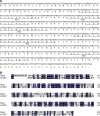
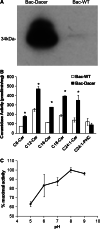
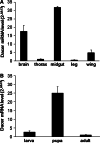
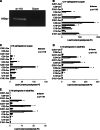

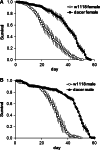
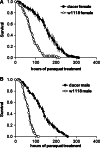
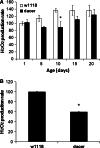

Similar articles
-
Alkaline Ceramidase Mediates the Oxidative Stress Response in Drosophila melanogaster Through Sphingosine.J Insect Sci. 2019 May 1;19(3):13. doi: 10.1093/jisesa/iez042. J Insect Sci. 2019. PMID: 31115476 Free PMC article.
-
Transcriptional changes revealed genes and pathways involved in the deficient testis caused by the inhibition of alkaline ceramidase (Dacer) in Drosophila melanogaster.Arch Insect Biochem Physiol. 2021 Mar;106(3):e21765. doi: 10.1002/arch.21765. Epub 2021 Feb 15. Arch Insect Biochem Physiol. 2021. PMID: 33590535
-
Alkaline ceramidase family: The first two decades.Cell Signal. 2021 Feb;78:109860. doi: 10.1016/j.cellsig.2020.109860. Epub 2020 Dec 1. Cell Signal. 2021. PMID: 33271224 Review.
-
CDase is a pan-ceramidase in Drosophila.Mol Biol Cell. 2011 Jan 1;22(1):33-43. doi: 10.1091/mbc.E10-05-0453. Epub 2010 Dec 9. Mol Biol Cell. 2011. PMID: 21148295 Free PMC article.
-
Ceramidases: regulators of cellular responses mediated by ceramide, sphingosine, and sphingosine-1-phosphate.Biochim Biophys Acta. 2008 Sep;1781(9):424-34. doi: 10.1016/j.bbalip.2008.06.002. Epub 2008 Jun 13. Biochim Biophys Acta. 2008. PMID: 18619555 Free PMC article. Review.
Cited by
-
Neutral Ceramidase Is Required for the Reproduction of Brown Planthopper, Nilaparvata lugens (Stål).Front Physiol. 2021 Feb 24;12:629532. doi: 10.3389/fphys.2021.629532. eCollection 2021. Front Physiol. 2021. PMID: 33716775 Free PMC article.
-
Ether lipids and sphingolipids drive sex-specific human aging dynamics.Redox Biol. 2025 Jul 18;85:103779. doi: 10.1016/j.redox.2025.103779. Online ahead of print. Redox Biol. 2025. PMID: 40706291 Free PMC article.
-
Ceramides in non-communicable diseases: pathways, nutritional modulation, and therapeutic opportunities.J Physiol Biochem. 2025 Aug 19. doi: 10.1007/s13105-025-01116-4. Online ahead of print. J Physiol Biochem. 2025. PMID: 40828428 Review.
-
The Role of Ceramide and Sphingosine-1-Phosphate in Alzheimer's Disease and Other Neurodegenerative Disorders.Mol Neurobiol. 2019 Aug;56(8):5436-5455. doi: 10.1007/s12035-018-1448-3. Epub 2019 Jan 5. Mol Neurobiol. 2019. PMID: 30612333 Free PMC article. Review.
-
Capsaicin Alleviates Vascular Endothelial Dysfunction and Cardiomyopathy via TRPV1/eNOS Pathway in Diabetic Rats.Oxid Med Cell Longev. 2022 May 12;2022:6482363. doi: 10.1155/2022/6482363. eCollection 2022. Oxid Med Cell Longev. 2022. Retraction in: Oxid Med Cell Longev. 2024 Jan 9;2024:9868092. doi: 10.1155/2024/9868092. PMID: 35602097 Free PMC article. Retracted.
References
-
- Okino N, Ichinose S, Omori A, Imayama S, Nakamura T, Ito M. Molecular cloning, sequencing, and expression of the gene encoding alkaline ceramidase from Pseudomonas aeruginosa. Cloning of a ceramidase homologue from Mycobacterium tuberculosis. J Biol Chem. 1999;274:36616–36622. doi: 10.1074/jbc.274.51.36616. - DOI - PubMed
Publication types
MeSH terms
Substances
Grants and funding
LinkOut - more resources
Full Text Sources
Molecular Biology Databases

